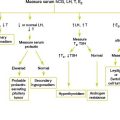Chapter 26 HYPERCOAGULABLE STATES
Risk Factors for Venous Thrombosis
Activated Protein C Resistance or Protein C Concentrate Administration
Chemotherapy (L-asparaginase, prednisone)
Inherited or acquired thrombophilias
Oral contraceptive and other estrogen use
Previous venous thromboembolism
Renal disease (chronic renal disease, nephrotic syndrome)
1. Alpert M.A. Homocysteine, atherosclerosis, and thrombosis. South Med J. 1999;92:858–865.
2. Barger A.P., Hurley R. Evaluation of the hypercoagulable state: whom to screen, how to test and treat. Postgrad Med. 2000;108:59–66.
3. DeStefano V., Finazzi G., Mannucci P.M. Inherited thrombophilia: pathogenesis, clinical syndromes, and management. Blood. 1996;87:531.
4. Faioni E.M., et al. Free protein S deficiency is risk factor for venous thrombosis. Thromb Haimost. 1997;78:1343.
5. Federman D.G., Kirsner R.S. An update on hypercoagulable disorders. Arch Intern Med. 2001;161:1051–1056.
6. Hoppe C., Matsunaga A. Pediatric thrombosis. Pediatr Clin North Am. 2002;49:1257–1283.
7. Koster T., et al. Role of clotting factor VIII in effect of von Willebrand factor on occurrence of deep-vein thrombosis. Lancet. 1995;345:152–155.
8. Poort S.R., et al. A common genetic variant in the 3’-untranslated region of the prothrombin gene is asscociated with elevated plasma prothrombin levels and an increase in thrombosis. Thromb Haimost. 1997;78:1430–1433.
9. Tait R.C., et al. Prevalence of protein C deficiency in the healthy population. Thomb Haimost. 1995;73:87.
























